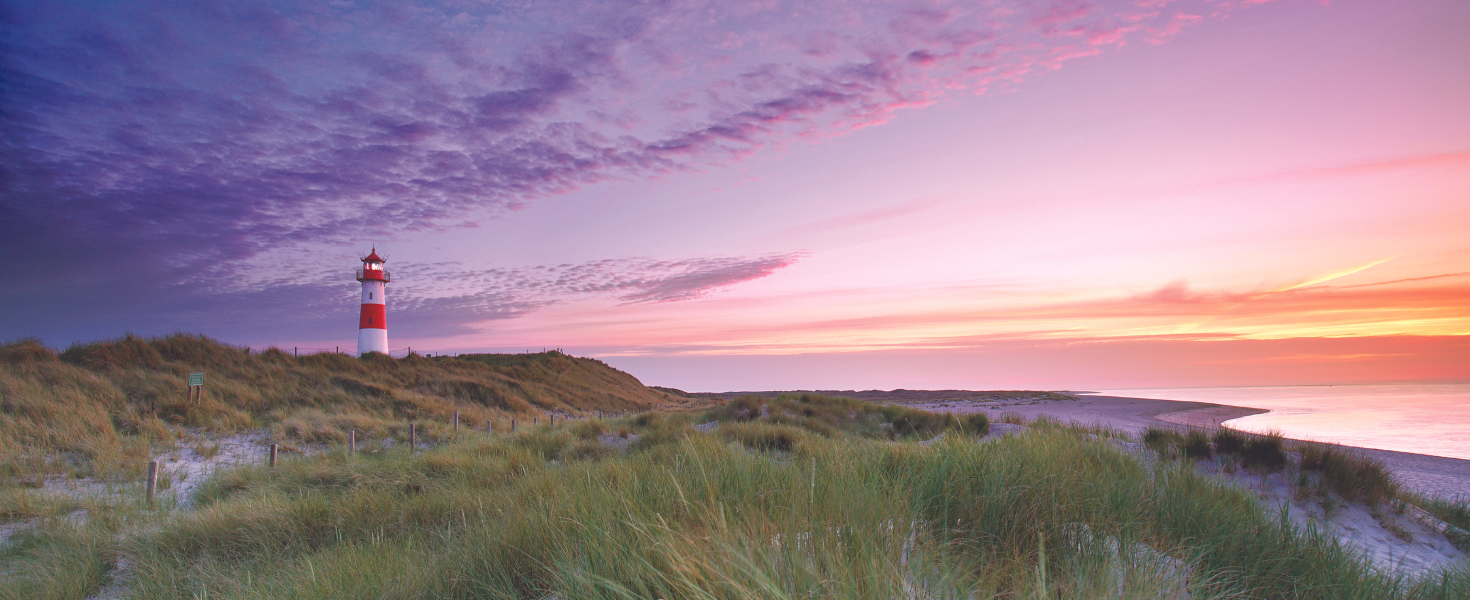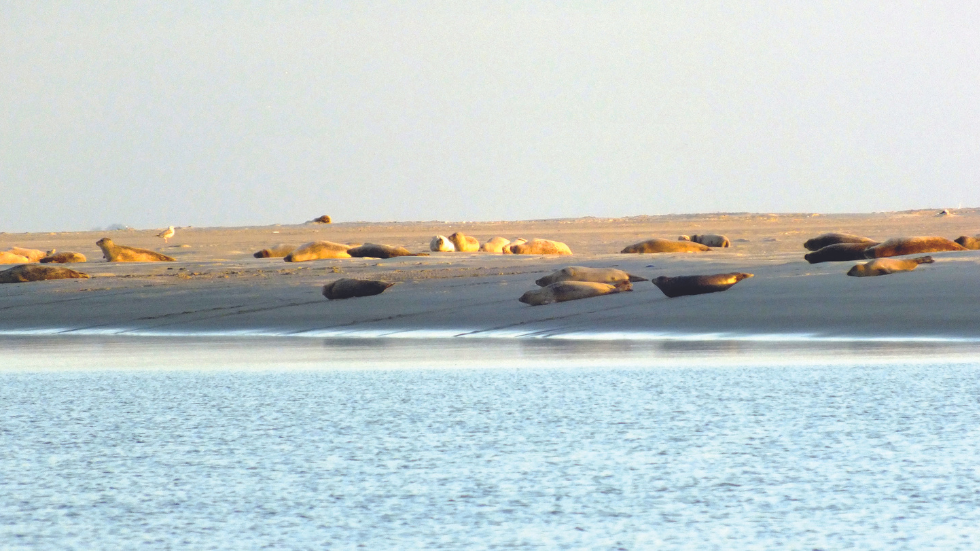Summertime in Germany’s Frisian Islands
Along the North Sea coast, a string of islands beckons with lighthouses and UNESCO World Heritage beaches

The sea breeze whips through my hair as I crest the top of the Uwe Dune. From here, I can see much of the German island of Sylt: the sun glinting off the North Sea; the thatched-roof houses of the town of Kampen; and a rolling landscape where, in summer, wild roses and heather burst into shades of pink and purple.
I’m a long way away from the lederhosen and beer gardens of Bavaria.
In the German islands, travelers climb sand dunes instead of Alps. They photograph lighthouses instead of castles. They dine on cod and oysters instead of sausages (even if they still indulge in German beer). The islands promise a break from the ordinary that travelers relish.
ONLY IN THE WADDEN ISLANDS
I didn’t expect balmy weather when I got to Sylt, one of Germany’s Frisian Islands, in February. Most travelers visit in summer when temperatures peak in the low 70s and water temperatures, which can always be described as bracing, approach 65 degrees. In winter, air and water temperatures hover around 40.
But the cool temps didn’t faze me. I had come for water, wide open spaces and someplace off the beaten path—and that I had in abundance.
Germany claims roughly 30 Frisian Islands (totals fluctuate with sea levels), also called the Wadden Islands. They form a part of the 50-island archipelago that stretches from the northwest of the Netherlands to southern Denmark. Carved out by the erosive power of North Sea surf and tides, which piled up sand deposits in some areas and sculpted away earth in others, the islands create a natural barrier between the sea and the mainland.
.png)
The 500-mile-long tidal mudflats of the Wadden Sea teem with sea life and shorebirds; Photo courtesy of German National Tourism Office
Lying between the Frisian Islands and continental Europe is the Wadden Sea, which takes its name from the Old Frisian word wad, meaning shallow waters that can easily be waded. The Wadden Sea incorporates a broad swath of coastal wetland immersed in sea water at high tide and, at low tide, exposed to reveal a nearly 500-mile intertidal sand and mudflat ecosystem, the largest such environment in the world. The landscape, its flora and its fauna are so unique that the Wadden Sea garnered UNESCO World Heritage status in 2009.
As distinct as the islands are from the European mainland, so, are their language and culture. Here, residents are largely of Frisian ethnicity, speaking the little-known language of the same name. Whether they live on an island belonging to the Netherlands, Denmark or Germany, Frisians often share more in common with one another than they do their compatriots across the water.
GERMANY’S HAMPTONS
Sylt ranks as the northernmost of Germany’s Frisian Islands, 3.5 hours by rail from Hamburg. The train carries visitors and their cars alongside smooth gray-green water, across a narrow, reclaimed land bridge that links Sylt to the continent. Although automobiles are allowed on the island, there is no roadway across the dam.
Sylt’s verdant farmland produces the ingredients prized by island chefs, ingredients I couldn’t wait to dig into: asparagus and strawberries in spring; potatoes and green vegetables as the seasons progress; grass-fed lambs and free-range poultry year-round. The North Sea provides cod and herring. The mudflats yield oysters and shellfish.
.png) Fish sandwiches for sale at a food stand in northern Germany; Photo courtesy of German National Tourism Office
Fish sandwiches for sale at a food stand in northern Germany; Photo courtesy of German National Tourism Office
Its wild, natural beauty notwithstanding, this island ranks as Germany’s poshest, often called the German Hamptons. Quaint thatched-roof houses and simple fish sandwich shops belie the celebrities who have over the years claimed Sylt as their quiet vacation hideaway, including Marlene Dietrich, Thomas Mann, Boris Becker and Kevin Costner.
Wooden promenades trace Sylt’s seashore and are particularly popular in the resort towns of Westerland, Wenningstedt and Kampen. I spent hours walking those boardwalks, photographing lighthouses, circumventing the most fragile dunes and descending stairways to comb the beach. In summer, the waterfront here and throughout the Frisian Islands is dotted with Strandkörbe wicker beach chairs. Visitors reserve the chairs through their local hotel, identifying their assigned Strandkorb by the number printed on its side. In winter, the beach chairs packed away, I found the sand scattered with interesting seashells and the tracks of shorebirds.
.png) A boardwalk follows the beach of the North Sea coast and its straw beach chairs on the island of Sylt; Photo courtesy of German National Tourism Office
A boardwalk follows the beach of the North Sea coast and its straw beach chairs on the island of Sylt; Photo courtesy of German National Tourism Office
The wooden promenade in Westerland looks out over the stretch of North Sea beach where in August and September the Kiteboarding and Windsurf World Cups take place, exploiting the island’s near-constant wind. Westerland’s Musikmuschel amphitheater offers free concerts in the summer. Locals dine on fresh fish and ice cream and sip crisp beers while they await the sunset at promenade restaurants that repurpose old Strandkörbe as dining booths.
Visitors who want to venture outside town can hop aboard Sylt’s SVG buses. Better still is to join locals on an e-bike ride. A network of well-marked, paved bike trails spans the island’s 20-mile length, a route that, while flat, I found challenging on windy days. Pedaling the island allows visits to the Uwe Dune with its sweeping views, five island lighthouses and a grouping of prehistoric burial mounds dating to the Bronze Age.

Harbor seals on Borkum, one of northern Germany’s 30 Frisian islands; Photo by winterbilder/Stock.Adobe.com
JUIST AND MORE
More than a dozen of Germany’s Frisian Islands welcome vacationers. The island of Borkum, which very nearly straddles the Dutch border, is famous for its seal colony and the Borkumer Kleinbahn, Germany’s oldest island train. Norderney focuses on health and wellness and is home to bade:haus, Europe’s largest Thalasso spa. And the quiet island of Föhr, sheltered from the worst of the North Sea weather, tends to be warmer and greener than other Frisian Islands.
But my next island visit would be Juist. Accessible by ferry from Norddeich, which in turn is a 3.5-hour journey by train from Bremerhaven, Juist (pronounced YOOST) is as quiet as any of Germany’s inhabited islands and is off-limits to all but emergency motorized vehicles. Travelers to this island arrive prepared to slow down. They get around on foot, by bicycle or by horse-drawn carriage.
.png)
Bicycles are the preferred means of transportation in the German Frisian islands; Photo courtesy of German National Tourism Office
Julia Findeisen, who handles tourism marketing for the island, explained to me the typical day for a Juist vacationer. “Usually, visitors sleep in late. They may begin their day spending a few hours reading a book over coffee or just watching the seashore. Then they walk to the beach and ask themselves, ‘Shall I turn right? Or shall I turn left?’ People come to Juist not to do things, but to do nothing."
Still, I found plenty to do on Juist even given my off-season visit. I hiked the Otto Leege path, which leads about 1 mile from the island’s southern Wadden Seaside and the mudflats to its northern North Sea coast. Up and over windswept dunes, alongside a freshwater pond and past sculptures created from natural materials, the trail guided me through half a dozen habitats and to numerous scenic overlooks. Interpretive signs were in German but helpful nonetheless thanks to good graphics.
I visited the Nationalpark-Haus, a visitor center focused on the Wadden Sea National Park that had excellent interactive displays exploring the region’s unique geology, flora and fauna. English brochures and an English-speaking staff helped me to understand what I was seeing when I surveyed the mudflats. I sampled citrusy-sweet Sanddorn liqueur, made from the orange seaberries that grow along the shore. I was lulled by the omnipresent clip-clop of horse hooves.
.png)
A fire warms the interior of the popular Juist teahouse Lütje Teehuus; Photo by Amy S. Eckert
And I visited the island’s most popular teahouse, Lütje Teehuus, a humble brick building that exuded warmth from the moment I opened the door. An exposed timbered ceiling, blue-and-white Delft tilework and a white brick fireplace welcomed me. I sat near the roaring fire on this damp day and ordered a pot of tea. The Frisians are as enamored of their afternoon cuppa as the British, according to locals. My table was set with a fine china service—a delicate cup and saucer, milk pitcher and sugar bowl—and a teapot stand furnished with a votive candle to keep the drink hot.
WADING INTO THE WADDEN
To really appreciate the Wadden Sea, I needed to, well, wade in. Given the sometimes-erratic tidal changes, it wasn’t safe to go alone. And alone, I was unlikely to understand what I was looking at. So, I turned to Sven Frank, who guides tours of Sylt’s Wadden Sea National Park.
Clad in black rubber boots, my anorak zipped chin-high to deflect the powerful, damp wind, I followed Frank at low tide into what looked like wet cement. He walked with purpose toward the water, armed with a digging fork, unbothered by the mud that sucked at our boots.
.png)
A Wadden Sea guide sets off in search of sea creatures in the mudflats; Photo courtesy of German National Tourism Office
More than 6 million birds can congregate here at peak migration season. Prawns, flatfish and sea lettuce flash their colors in the shallow water alongside masses of blue and Pacific oysters, their shells glued together in happy coexistent clumps. When we bent to look closely, the mud revealed the trails of tiny mudsnails smaller than a grain of rice that graze on the mudflats’ algae. And we saw mounds of sand spaghetti.
Frank plunged s his fork into the exposed mud, and we observed the source of these noodles: an 8-inch lugworm that lives below the surface, ingesting sea water, filtering it and ejecting the purified sand into spaghetti-like mounds. Frank’s fork also turned up cockles and an array of mussels, Baltic clams and the peppery furrow shell.
Having finished his tour of the mudflats, Frank straightened up and surveyed the island and its shoreline with a satisfied look on his face. “There is so much life in these islands if you only know where to look,” he said. So much to see, too, on dry land and in the mud
